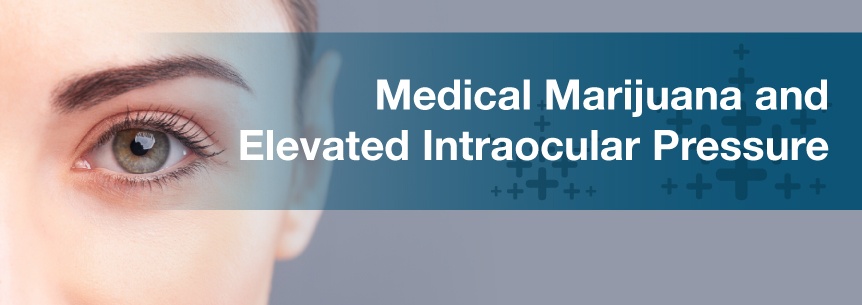
If you just received a diagnosis for elevated intraocular pressure, naturally you have concerns. If the condition declines, it can cause glaucoma — and, even worse, cause you to go blind. The good news is with early detection and the right treatment, you can get your eye pressure back to normal and relieve other symptoms.
While eye doctors prescribed medicated eye drops as the first defense, medical marijuana and elevated intraocular pressure treatment can help with other symptoms you might not even associate with intraocular pressure, such as anxiety, depression, trouble sleeping and more. It can even help with the headaches you may get from elevated eye pressure.
Elevated intraocular pressure, also called high intraocular pressure (IOP) and ocular hypertension, is a fluid pressure measurement inside your eye. You measure it like you would your blood pressure.
A jelly-like substance called vitreous humor fills most of the back area of your eye. There’s also a watery liquid called your aqueous humor in front of the iris and behind your cornea.
Normally, your eye naturally balances itself by allowing new aqueous humor to enter as an equal amount drains out. Most of it flows through your drainage angle, in the front of your iris and out your eye, maintaining stable pressure.
With elevated intraocular pressure, the pressure is higher than average because the fluid hasn’t been able to drain adequately. If you don’t receive treatment, this high pressure can lead to optic nerve damage, cause glaucoma and result in permanent vision loss in some individuals. Some individuals can have elevated intraocular pressure or high intraocular pressure without developing any eye or vision damage, while others can have eye pressures in the normal range and still suffer optic nerve damage.
Normal eye pressure will range from 10 to 21 mm Hg. Elevated IOP is when your eye pressure is above 21 mm Hg.
Individuals who haven’t developed full-blown glaucoma, but have elevated IOP, are called glaucoma suspects. In some people who have open-angle glaucoma, the optic nerve damage occurs slowly, without them knowing it.
Glaucoma suspects are also those with other findings that may suggest glaucoma now or later because of elevated eye pressure or optic nerve damage. For instance, a person would be a glaucoma suspect if they had a strong family history of the condition or a suspicious optic nerve.
Since there aren’t usually outward symptoms or signs of elevated IOP — like red eyes or eye pain — in open-angle glaucoma, you can’t tell you have the condition by yourself. Your eye doctor will need to measure your IOP during a comprehensive exam and compare it with normal levels.
If your eye pressure is 21 mm Hg or higher, this typically indicates elevated intraocular pressure. Some individuals may feel pressure around their eyes, have a headache, have problems with glare or see halos around lights.
People who have very high intraocular pressure involved in acute angle-closure glaucoma can experience a severe headache, rainbow-colored halos around lights, nausea and/or vomiting and potentially a loss of sight. Acute angle-closure glaucoma is a sight-threatening condition and requires immediate treatment.
The factors that cause elevated IOP are pretty much the same as glaucoma’s causes. These causes include:
If your ciliary body makes an excessive amount of aqueous humor, your eye pressure increases and causes elevated IOP.
If your aqueous humor is draining from your eye too slowly and disrupts the even balance of your eye’s clear fluid’s production and drainage, this causes elevated IOP.
Some medications may cause elevated IOP in certain people. For instance, asthma treatment like steroid medications has increased people’s risk for high ocular hypertension.
In susceptible individuals, even the steroid eye drops doctors prescribe after refractive surgery like LASIK can cause high eye pressure. If a doctor prescribes you a steroid medication, speak with your eye doctor about seeing if you should increase your visits to have your IOP monitored.
An eye injury may impact the balance of the production and drainage of aqueous humor from your eye, potentially causing elevated IOP. In some cases, this can take place years after an injury. During your annual eye exam, let your eye doctor know if you’ve suffered any eye trauma.
Other eye conditions can cause ocular hypertension, including:
If you’re suffering from any of these conditions, let your eye doctor know. They may recommend you increase the frequency of your eye exams to monitor your eye pressure.
While there aren’t necessarily “types” of high IOP, there are two primary types of glaucoma.
This is glaucoma’s most common type and accounts for around 90 percent of all glaucoma cases, according to the Glaucoma Research Foundation. Some traits include:
It’s also called chronic or primary glaucoma.
Glaucoma’s less common type. Some traits include:
It’s also called narrow-angle glaucoma or acute glaucoma.
Elevated IOP slowly occurs through the aging process, similar to glaucoma becoming more prevalent as you age. A risk factor for developing both elevated intraocular pressure and primary open-angle glaucoma is being older than 40.
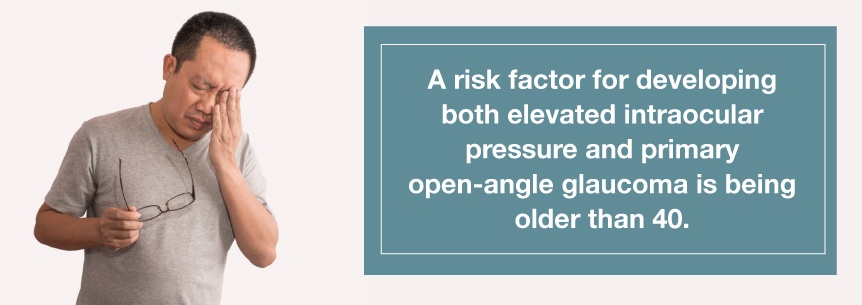
Elevated IOP in a younger person is a cause for concern. Being young exposes the person to high pressures for a longer time, and therefore a higher risk of optic nerve damage throughout their life.
Loss of vision can occur from glaucoma with extremely elevated IOP for certain people, and damages the optic nerve. Once there’s damage as a result, you can’t reverse it. The first to be affected is the peripheral vision, typically. The vision changes might be so gradual, you don’t notice them until you’ve already lost a lot of vision.
If you don’t treat glaucoma, over time, your central vision can start reducing as well, and you can eventually lose that. Often, this is how individuals realize they have a glaucoma-related visual impairment. Fortunately, if detected early, glaucoma is treatable, and you won’t lose your sight with medical or surgical treatment.
Visual impairment is a concern both nationally and globally, and has a negative effect on mental health as well, reports the American Academy of Ophthalmology. Visually impaired individuals are at a higher risk for:
A study published in the Journal of Glaucoma linked primary open-angle glaucoma to anxiety and depression.
Another study, published in The Journal of Neuropsychiatry and Clinical Neurosciences, showed a higher prevalence of trait anxiety, depression and sleep disturbances in individuals who had progressed glaucoma, compared to those with mild glaucoma or no visual impairments.
Facts about glaucoma, according to the Glaucoma Research Foundation, include:
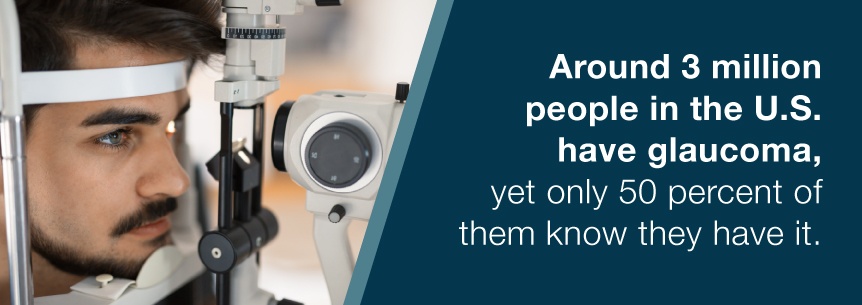
The ancient Greeks first mentioned glaucoma in their written works. Hippocrates described the term “glaykoseis” as blindness that affects the elderly. The term glaucoma, meaning blue-green or clouded hue, came from ancient Greek and was probably describing an individual who was developing cataracts rapidly or had a swollen cornea — both of which could be a result of chronic elevated IOP inside the eye.
Your eye doctor will decide on the best approach to treat your elevated intraocular pressure. They might prescribe you medicine or just monitor you, depending on your individual case. They’ll go over the pros and cons of medicine versus monitoring with you.
Some ophthalmologists prescribe topical eye drop medications to treat IOPs above 21 mm Hg. Others don’t prescribe treatment unless they see evidence of optic nerve damage. Some eye doctors will treat individuals if their pressures are higher than 28 to 30 mm Hg consistently, since this has a higher risk of causing optic nerve damage.
If you’re experiencing signs and symptoms like blurred vision, halos or pain, or your intraocular pressure continues to increase, your ophthalmologist will likely start you on treatment.
Once your eye doctor prescribes you medication, you’ll need to book follow-up appointments with them. You may need more than one prescription eye drop, or conduct trials and errors to determine the optimal drop or drops combination for you.
Today, you have a choice of several different types of glaucoma eye drop medications, including:
Typically, if one or two medications don’t seem to lower the eye pressure, you may require other treatment plan steps.
Surgical and laser therapy aren’t always a first-line defense for treating elevated IOP, due to the risks linked with these two therapies being greater than the risk of developing ocular hypertension-related glaucomatous damage. However, if you can’t tolerate prescription eye medicines or you have developed glaucoma as a result of elevated intraocular pressure and optic nerve damage, your next option may be surgery, either in the form of lasers or traditional incisional types.
Laser surgeries include:
Traditional incisional surgeries include:
The goal of new advances is to make treatment for glaucoma more effective and easier. For instance, patients who can’t achieve normal pressure from prescription eye medications or those who don’t want to use eye medications would have other treatment options besides the standard invasive glaucoma surgery.
Two new drops for glaucoma have become available in 2018. They are called Rhopressa and Vyzulta.
Also, technology has become available in recent years to try to avoid traditional filtration surgery complications by accessing and enhancing the eye’s natural aqueous drainage pathways. Micro-invasive or minimally invasive glaucoma surgery allows surgeons to treat patients more safely and earlier than with standard surgeries.
There are also more than 1,300 clinical trials on treatment advances for glaucoma.
The idea that medical marijuana can be effective in treating eye conditions dates back to the early 1970s, and research studies confirm it. Studies showed smoking marijuana would have positive effects in trying to lower the IOP levels of people who suffer eye conditions such as glaucoma.
When a person with IOP smokes marijuana or takes a form of its active ingredient, it is capable of effectively lowering a patient’s IOP levels. However, since marijuana only lowers IOP levels for three to four hours, you would need to smoke it six to eight times a day around the clock to receive the benefit of consistently lowered IOP levels to clear vision. Some states have approved glaucoma as a qualifying condition.
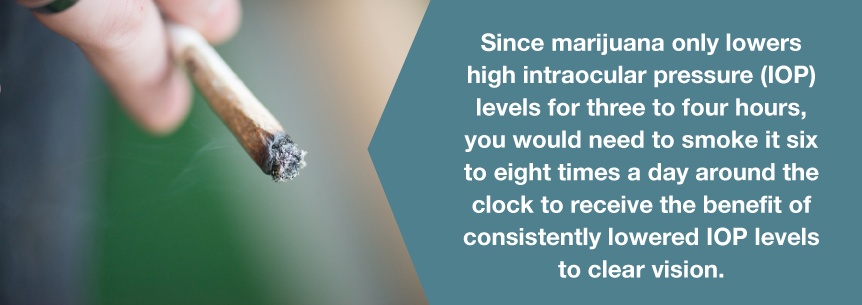
Please note, cannabis does have side effects. It can cause decreased blood pressure and tachycardia in glaucoma patients. These reduce the flow of blood to the optic nerve that’s already compromised. Smoking the herb long-term can lead to chronic obstructive pulmonary disease and could increase your lung cancer risk.
Also, research shows people who smoke cannabis or take its active ingredient by injection or pill enjoy lowered IOP, reports the Glaucoma Foundation. Smoking marijuana could also lower blood pressure, which could result in reducing the blood supply to the optic nerve, causing damage.
Medical marijuana for elevated intraocular pressure can help treat symptoms such as:
Pot also works as a vasodilator, helping improve circulation and keeping blood vessels open. Often, marijuana-based treatments reduce eyeball pressure that impinges on optical blood vessels, nerves and valves.
Countless research studies worldwide show medical weed is effective in treating glaucoma.
The standard ophthalmology strategy for reducing high IOP is by removing blockages caused by infection, debris or inflammation. Cannabis for elevated intraocular pressure impacts this eye condition in three ways:
Here are some medical cannabis for elevated intraocular pressure strains to check out.
These are ideal to use in the evening because they’re relaxing. They offer you relief from your IOP pain.
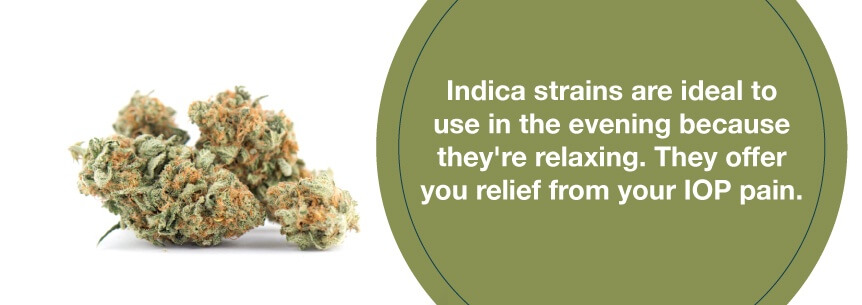
Some Indica strains include:
These strains are more invigorating and energizing and perfect for daytime use. They provide you relief from IOP and glaucoma side effects like headaches and nausea. Some Sativa strains include:
These are a blend of both Indica and Sativa strains. Some suitable cannabis and elevated intraocular pressure hybrid strains are:
If you’re using medical cannabis to treat elevated IOP, there are numerous ways you can administer it. Some include:
Once you schedule your appointment with a qualified cannabis doctor and receive your recommendation, they’ll consult with you about all the different methods you can use for your marijuana for elevated intraocular pressure treatment.
Some will benefit you more than others. For instance, since you want long-lasting relief from elevated IOP, edibles would be a better choice, so you wouldn’t have to smoke the herb six to eight times a day.
For more up-to-date information on glaucoma and cannabis, and to consult with a marijuana doctor, visit MarijuanaDoctors.com. Here you’ll have a comprehensive library of resources to learn as much as possible about medical marijuana, state laws, side effects, qualifying conditions and more. You’ll also have access to an extensive list of dispensaries to obtain your marijuana and elevated intraocular pressure treatment. Book your appointment today.
Find A Doctor Find A Dispensary